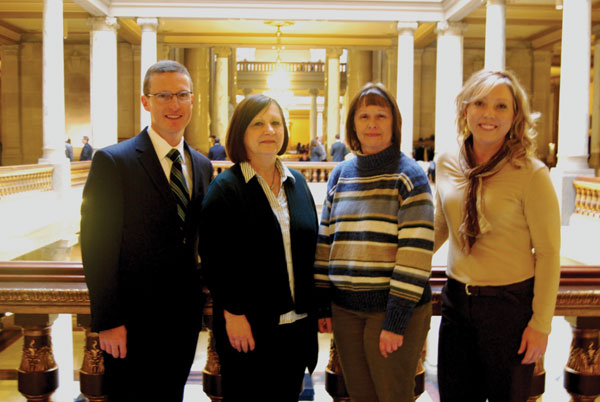In 2012 more than 1.5 million cases were filed in Indiana courts. All of those cases, one way or another, passed through the hands of court staff in one of Indiana’s 92 county court systems. Very few find their way to the appellate courts in Indianapolis, but just what does happen to them when they get there?
Clinton County Superior Court Judge Justin Hunter and his Clinton County court staff found out on February 19, 2013 during their visit to the state capitol. Judge Hunter arranged the visit as a way to express his appreciation for all his staff does to keep his court running smoothly. His staff heard the same thing, “thank you so much for what you do,” from just about everyone they met that day.

Indiana Supreme Court Justice Steven David greeted the Clinton County visitors and gave them a personal tour of his chambers, the Supreme Court courtroom, and a behind-the-scenes peak at the Court’s conference and robing rooms. Justice Loretta Rush and Justice David, both former trial court judges, thanked Judge Hunter’s court reporters, Michelle Rose and Crystal Randolph, and the office administrator, Linda Wheeler, for the work they do to make sure the appellate courts receive everything they need when a case is appealed. Justices David and Rush made special mention of the importance of the record and transcript they receive from the trial courts.
Next, the group visited Deputy Clerk of the Supreme Court, Court of Appeals and Tax Court, Heather Smith and her staff. Ms. Smith literally walked the visitors through her office to demonstrate what happens when the transcript and record arrives from a trial court. Michelle Rose and Crystal Randolph were especially interested in the vault in the clerk’s office where all the appeals were previously stored and the Records Office where the documents are kept prior to microfilming.
A brief visit to the Rotunda filing box rounded out the morning. Prior to the institution of strict security measures in the State House, attorneys could even file briefs after working hours with the State Police, often in the rotunda area of the State House. When security measures were put into place, including locking the building at 5 p.m., the Clerk had to make new arrangements for after-hours filings and created a “rotunda filing station” in the vestibule area at the Capitol Avenue entrance of the State House.
Following a quick lunch and brief visits with Clinton County legislators, the group finished the day with a tour of the State House conducted by the Capitol Tour Office. Indiana’s capitol building, completed in 1888, is one of only a few historic state capitols that continue to serve as the center of the state’s daily government operations. In addition to the Governor, the General Assembly, and the Supreme Court, many other executive offices are housed in the building.
As with most visitors, and even the people who work here, Judge Hunter and his staff were overwhelmed by the beauty and grandeur of the building. The State House is a fitting testimony to Hoosiers’ commitment to the importance of a well run state government.